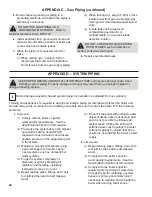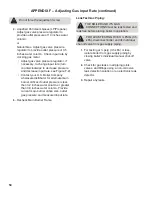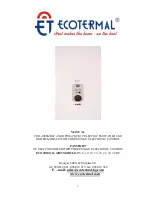
39
APPENDIX B – VENTING
VENT THIS BOILER according to the instructions. Failure to do so may cause products of
combustion to enter the building resulting in severe property damage, personal injury or death.
i
Install this boiler according to this manual and the National Fuel Gas Code, ANSI Z223.1/NFPA 54,
the Natural Gas and Propane Installation Code, CAN/CSA B149.1, or applicable provisions of the
local building codes. Contact local building or fire officials about restrictions and installation
inspection in your area. In addition to previously mentioned vent
codes of the main general guidelines,
atmospheric vented installations must also be in accordance with the Standard for Chimneys, Fireplaces,
Vents and Solid Fuel Burning Appliances, ANSI/NFPA 211. For Canada installations, refer to the Natural
Gas and LP Installation Code, CAN/CSA- B149.1.
1.
Per ANSI Z223.1/NFPA 54 the vent terminal
shall have a minimum clearance of 4 feet
(1.22 mm) horizontally from, and in no case
above or below, unless a 4 feet (1.22 mm)
horizontal distance is maintained, from
electric meters, gas meters, regulators and
relief equipment for U.S. installations. Per
B149.1 this minimum distance shall be 6 feet
(1.83 m) for Canadian installations.
2.
IF AN EXISTING BOILER IS REMOVED
When an existing boiler is removed from
a common venting system, the common
venting system is likely to be too large for
proper venting of the appliances remaining
to it.
At the time of removal of an existing boiler,
the following steps shall be followed with
each appliance remaining connected to the
common venting system placed in operation,
while the other appliances remaining
connected to the common venting system
are not in operation:
(1)
Seal any unused openings in the
common venting system.
(2)
Visually inspect the venting system
for proper size and horizontal pitch
and determine there is no blockage
or restriction, leakage, corrosion, and
other deficiencies which could cause an
unsafe condition.
(3)
Insofar as is practical, close all
building doors and windows and all
doors between the space in which the
appliances remaining connected to the
common venting system are located
and other spaces of the building. Turn
on clothes dryers and any appliance
not connected to the common venting
system. Turn on any exhaust fans, such
as range hoods and bathroom exhausts,
so they will operate at maxi mum speed.
Do not operate a summer exhaust fan.
Close fireplace dampers.
(4)
Place in operation the appliance
being inspected. Follow the Lighting
(or Operating) Instructions. Adjust
thermo stat so appliance will operate
continuously.
(5)
Test for spillage at the draft hood relief
opening after 5 minutes of main burner
operation. Use the flame of a match or
candle, or smoke from a cigarette, cigar
or pipe.
(6)
After it has been determined that each
appliance remain ing connected to the
common venting system properly vents
when tested as outlined above, return
doors, win dows, exhaust fans, fireplace
dampers and any other gas burning
appliance to their previous conditions of
use.
(7)
Any improper operation of the common
venting system should be corrected
so the installation conforms with the
National Fuel Gas Code
, ANSI Z223.1/
NFPA 54, and/or
Natural Gas and
Propane Installation Code
, CAN/CSA
B149.1
.
When resizing any portion
of the common venting system, the
common venting system should be
resized to approach the minimum size
as determined using the appropriate
tables in Chapter 13 of the
National Fuel
Gas Code
, ANSI Z223.1/NFPA 54, and/
or
Natural Gas and Propane Installation
Code
,
CAN/CSA B149.1.
















































